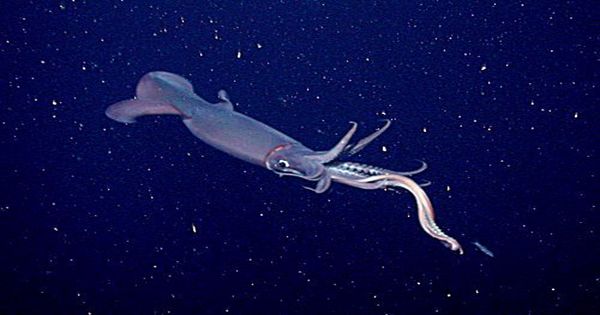Now, a new study published in the journal PLOS One details the incredible discovery of five Bigfin squid in the Great Australian Bite, the first time they have been seen in Australian waters. The ocean is home to some perfect whoppers and some of the largest animals are also the most elusive. One such giant is the Bigfin Squid, which belongs to the Magnapinnidae family, a large group of tall, tall, noodle-armed, and tented deep-sea squid. It was only stained with meat on a few occasions.
Previous reports of these sea monsters have always been of a single person, so capturing five of them on camera is a big deal for the team at the Australian National Science Institute CSIRO. All five were spotted at depths of 2 to 3 kilometers (about 1.5 miles) over a 25-hour period, but they were within 300 meters (984 feet) of each other, creating a steep crowd for an animal that had never been seen before more than one. Although they were not identified at once, there was a slight difference in the appearance of the Bigfin, which made it easier for the team to recognize that they were not just a camera-hungry squid, but five separate animals.
The largest man was 1.8 meters (about 6 feet) tall, with a length of about 11 times his body size. The animal was mostly white at the suggestion of its arms and tentacles but it played a mixture of brown, orange, and pink on its upper limbs, covering and towards the bird. Observers on the squad have never before shown such behavior, as Bigfin has adopted a high-sleeved dress known as the ‘elbow’ pose. The discovery of the first type provides a unique opportunity to shed some light on these deep creatures and the team was able to get an accurate lesson on their size for the first time. The previous-situation involves objects measuring their measurement attempts like objects close to a thickness such as an immersive wow, but in this new study, lasers are used to get a more accurate image of their size.
In an email to IFLScience, Deborah Osterhage, a marine scientist from CSIRO, said, “We filmed five bigfin squids at a depth of 2 to 3 kilometers using a twisted camera system and remotely operated vehicle (ROV).” “We were conducting an image-based survey to find out more about the deep-sea environment of the Great Australian Bytes. The first two towed camera footage was seen when the video was seen back off the coast in the lab. We recognized them as Bigfin squid and knew it was rare to see them so in the next ROV survey we really kept an eye on them. We were lucky enough to see three more and were able to see RV in real-time on the ship while filming them – quite exciting!
“Bigfin squid and many other deep-sea cephalopods are rarely known for their accessibility to the hugely explored deep-sea environment and can learn a lot more about the deep sea and the incredible creatures that live there. So, we’ll have to wait for more scenes for the Bigfin Squid, or more specifically an adult specimen of better condition – which has never been collected before. “














